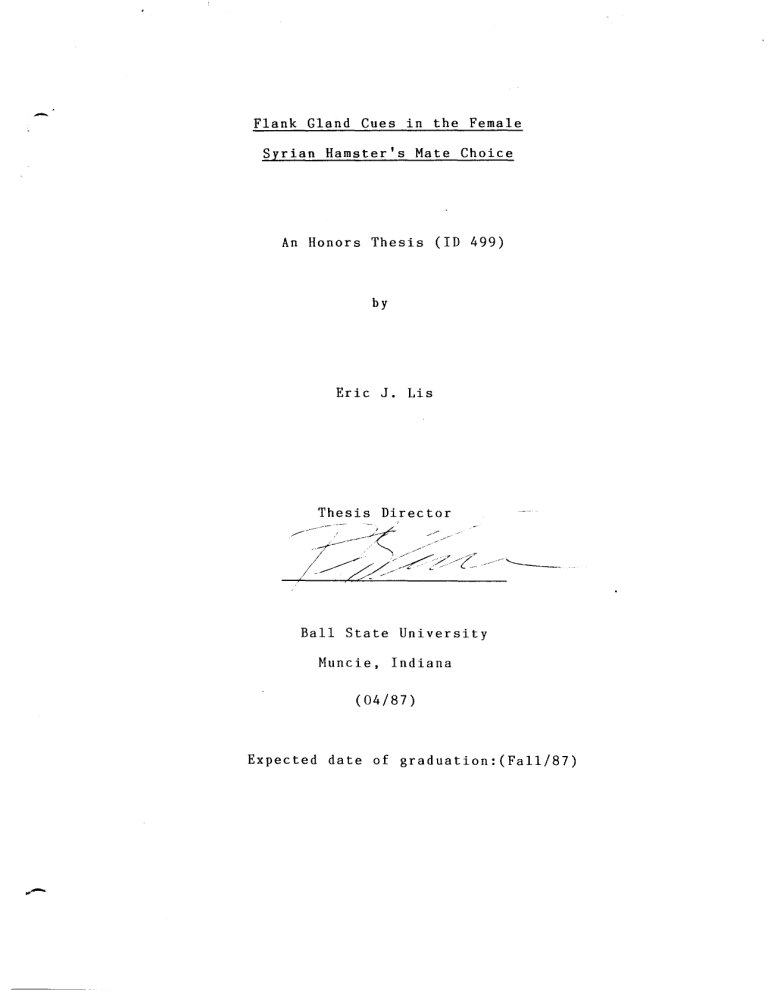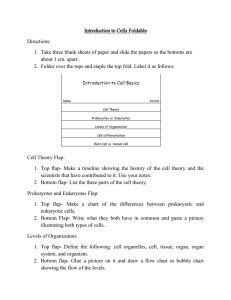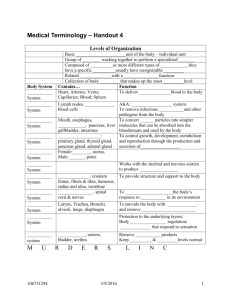by J.

Flank Gland Cues in the Female
Syrian Hamster's Mate Choice
An Honors Thesis (ID 499)
by
Eric
J.
Lis
Ball State University
Huncie, Indiana
(04/87)
Expected date of graduation:(Fall/87)
-
ABSTRACT
Eight female Syrian hamsters were given a choice between a familiar male vs. a novel male in a plexiglass arena (120 cm. x 120 cm.). Familiarity is determined by the female's previous exposure to the flank gland odor of the familiar male. The study demonstrates a positive relationship between female mate choice and flank gland familiarity.
I ,
-
-
INTRODUCTION
Many studies on the specialized glandular areas of male rodents support an aggressive function in social interactions. These specialized glandular areas have often been assumed to function in site defense or to exclude and intimidate male competitors ( Fullenkamp, Fisher, Vance;1986)~
Hamsters have clearly defined oval regions of enlarged, pigmented sebaceous glands on the dorsal portion of each flank which are called flank glands ( Montagna and Hamilto~
1950). A significant amount of data on flank gland marking supports an intimidation effect.Many studies indicate that there is a positive association between aggression and marking behavior ( Dieterlen,1959; Johnston,1975).Dieterlen
(1959) reported that flank marking was especially frequent after agonistic encounters, and suggested that i t was an agonistic behavior concerned with defense of territory.
Other experiments demonstrate that the size and pigmentation of the flank gland can be used as a predictor of social rank in male hamsters ( Drickamer, Vandenbergh, Colby;
1973).
Other data are not so consistent with an intimidation effect of flank gland substances ( Fullenkamp, Fisher,Vance;
1986). Males undergoing short photoperiod induced testicular regression increase their level of aggression, become more dominant but do not exhibit comparable increases in marking behavior ( Garrett and Campbell,1980). Lipkow
(1954) claimed that the gland was of sexual importance,
1·
particularly in sexual excitation of the female. He removed flank glands from several males and claimed females would not mate with them, or did so only after long latencies.
Daly (1977) hypothesized that if a female is repeatedly exposed to a male's scent marks she will habituate to his odors and be more likely to mate with him when she comes into estrous. This experiment addressed this issue by observing whether females would respond to the flank gland ollor of a familiar male versus a novel male in mate choice.
The data were examined by comparing the frequencies of mounts and intromissions performed by the males (familiar vs. novel) combined with the female total lordosis time with each male.
METHOD
SUBJECTS
Twenty-two Golden hamsters, eight females and fourteen males, were used in the study. As a rule, one female and two males were used for each test. The subjects were approximately six months old and are maintained on a 16:8, light: dark cycle.
APPARATUS
The hamsters were tested in a 102 x 102 cm. opell arena.
Each male was tethered in a harness which only allowed a limited range of movement (within a 30 x 38 cm. area). The female had equal access and vision of both males from any point in the arena. All testing was conducted under dim red illumination.
2 •
PROCEDURE
The males were randomly designated as either familiar or novel without any prior dominance testing. Flank gland smears from the familiar male were applied to a marked square (5 x
5 cm.) on the female's cage wall. The smears were applied once a day beginning with the female's estrous day and continuing until the next estrous, which was designated as the test day.
The female's estrous cycle had to be closely monitored via daily examination of vaginal mucous. Usually the female would demonstrate the typical four day estrous cycle, but there were exceptions. The female had to be in estrous for the test to be run.
On the test day, the last flank gland smear was applied thirty minutes before the trial run. The female was put into the arena for five minutes before the test to allow for familiarization. The males were tethered in the harnesses five minutes before the test, without female presence, to also allow for familiarization. The testing began after 9:00 A.M. which was the beginning of the hamster night cycle and the period of peak activity. The range of testing times for the eight trial runs was between 9:00 A.M. and 11:00 A.M .. The female was placed in the neutral area of the arena, with equal visibility of both tethered males. Each trial lasted approximately 35 to 60 minutes, with the frequency of mounts and intromissions being recorded along with the total lordosis time of the female in the respective regions of the arena (familiar vs. novel).
3.
-
RESULTS AND DISCUSSION
Table 1
Female Preference Test Results
VARIABLES FAMILIAR MALE vs. NOVEL MALE
Total Lordosis Time 134.35 mn. vs. 48.56 mn.
Mounts 384 vs. 130
Intromissions 160 vs. 66
20.11
62.759
19.548
==========:=======================================================
Figure 1
A Comparison of Means
J5~., r a.) sEM
T
1.;).3 5Etwt rL/9.'T
T
~."
Sf'"
[1C)o
Il,s."
~nSfM
.L
,",t'~
T
I. a~
5Er'I
.. 3
++++ ++++-1 ++++++++++++++ It+++ ++++ +++++++++++++++ fr+++ ++++ ++++++
FAM./NOVEL
MOUNTS
FAM./NOVEL
TLD (mn.)
FAM./NOVEL
INTROMISSIONS
*Note: SEM= Standard error, TLD= Total lordosis time
4 .
The results seem to indicate that the female hamster may use flank gland odor as a cue in choosing a potential mate.
The chi square values in Table 1 are significant in demonstrating a relationship between the familiar and novel male for the three variables tested. This data in Table 1 shows that there seemed to be a female preference for the familiar male in mate choice. The histogram in Figure 1, comparing the means of the variables, indicates a significantly greater frequency of female response towards the familiar male.
Although the variance in the data was considerably high in
Figure 1, as is indicated by the standard errors, the compos~te frequencies compiled in the eight trial runs is definitely in favor of the familiar male as the preferred mate.
This study provides further support for data which proposes that flank gland secretions may play a role in the process of mate selection. It is clear, according to some studies, that marking behavior is sexually dimorphic that i t tends to occur after aggressive encounters and that dominants often mark more frequently ( Dieterlen,1959; Johnston,1975).
Ohter data, including this study, are not so consistent with an intimidation effect of flank gland substances.
The basic question presented in this conflict is the function of the flank gland secretions in communication. There is suggestive evidence that the analgous ventral gland odor of gerbils functions not so much to intimidate other males
( Fullenkamp, Fisher, Vance,1986; Halpin and Noonan, 1982), but to familiarize the female with the male's odor (Daly,
1977; Garrett and Campbell,1980). Daly (1977) also suggested
5.
that this may be the case with hamsters. It may be that the more frequent flank marking by the dominant male serves both to advertise his presence and to familiarize the female with his odors ( Fullenkamp, Fisher, Vance;1986). Another possibility is that the flank odor may, like urine, convey information relevant to the male's status ( White, Fisher,
Meunier;1984).
In this study the males were randomly chosen (familiar or novel), without any consideration of status. Even though the males were not dominance tested, the results significantly indicate that the female preferred the familiar male. A projected experiment from this study involving dominance testing would provide valuable data in determining the role of male marking behavior, and also in comparing male status and familiarity in female mate choice. The projected study would use the same procedure that was used in this study except that the males would be dominance tested before the test runs. The key test run would compare the frequencies
( total lordosis time, mounts, intromissions) between a familiar submissive male versus a novel dominant male.
6 .
REFERENCES
1. Daly, M. 1977. Some experimental tests of the functional significance of scent marking by gerbils. J. Compo Physiol.
Psychol.
21,
1082-1094
2~ Dieterlen, F. 1959. Das Verhalten des Syrishen Goldhamsters. Z. Tierpsychol. ~, 47-103
3. Drickamer, L.C., J.G. Vandenbergh and D.R. Colby. 1973.
Predictors of dominance in the male Golden hamsters (Mesocricetus auratus). Animal Behavior.
11,
557-563
4. Fullenkamp, A.M., R.B. Fisher and R.A. Vance. 1986. A lack of avoidance of flank gland secretions by male Syrian hamsters. Physiology
&
Behavior.
11,
73-76
5. Garrett, J.W. and C.S. Campbell. 1980. Changes in social behavior of the male Golden hamster accompanying photoperiodic changes in reproduction. Horm. Behav. 14, 303-318
6. Halpin, Z.T. 1978. The effects of social experience on the odor preferences in the Mongolian gerbil (meriones unguiculates). BioI. Behav.
1,
169-179
7. Halpin, Z.T. and K.C. noonan. 1982. Social housing and odor preferences of the Mongolian gerbil. BioI. Behav.
2.
291-321
8. Hamilton, J.B. and W. Montagna. 1950. The sebaceous glands of the hamster I. Morphological effects of androgens on integumentary structures. Amer. J. Anat. 86, 199-233
9. Lipkow, J. 1954. Uber das Seitenorgan des Goldhamsters.
Z. Morph. U. Okol. Tiere. ~.333-372
10. Johnston, R.E. 1975. Scent marking by male Golden hamsters I. Effects of odors and social encounters. Z. Tierpsychol.
12,
75-98
11. Johnston, R.E. 1985. The Hamster, edited by H.I. Siegle.
New York: Plenum Press. 121-154
12. White. P.J., R.B. Fisher and G.P. Meunier.1984. Discrimination of male social status by female hamsters.
Psychol. Rep.
22.
487-491
7 .




